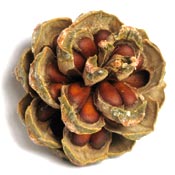Destroying America's pine nut groves while importing pine nuts from China?
Goods From The Woods
14125 Hwy C.
Licking Mo.
573-674-4567
August 28, 2000
Dear Public Lands Managers,
Recently, I reviewed several land management plans, including the Ely Fire Plan, and became greatly concerned that misconceptions about pinyon pinenuts might lead to poor decisions in planning and managing our public lands. While specifically referencing the Ely plan, I think it important to explore and discuss the potential for pinyon pinenuts harvested on public lands with land managers as a whole .
When I began working with pinenuts, 4 years ago, I was dumbfounded to learn that we import approximately 8 million lb. a year of pinenuts into this country each year. The potential for this sustainable, earth friendly, high protein food is phenomenal. A recent government periodical illustrates how we are just discovering the possibilities of domestic pinenuts:
I am greatly concerned that as the demand develops, the forest will not be available to support this market. This concern has intensified as late, while reading the Ely Prescribed Fire plan, www.nv.blm.gov/Ely/Fireplan, Apr13 .Page 10, Section 18, states:
Pinyon pinenuts are produced by young, vigorous trees, usually 60 - 100 years old.
This
a critical error!!
The correct information
is found among other places,on the BLM’s Battle Mountain
Field Office page which states:
[S]ingleleaf
pinyon trees do not begin bearing cones before they are 35
years old and do not
begin producing good seed crops earlier than 100 years.
www.nv.blm.gov/bmountain/misc/pinenut.
Citing, R. 0. Meeuwig,
J. D. Budy, and R. L. Everett http://willow.ncfes.umn.edu/silvics_manual/Volume_1/pinus/monophylla.htm
Prior to beginning my work with pinyon pinenuts, I was a research and litigation paralegal for Las Vegas lawfirm. It was that background which motivated me to thoroughly research pinyon pinenuts. I acquired materials available through U.S. Government sources. I sat down and read, and read, and read. I am enclosing several short pieces about the economic viability of pinenuts. I have clients from all over the world, who wish Great Basin Pinyon Pinenuts. People in Great Britian, Australia, Africa, Russia, China have all contacted me and asked for the availability of exported Great Basin pine nuts.
am asking for your support in creating new priorities in land management. The most important of which includes conservation of mature pinyon stands. Such policy would seem inherent to the fiduciary duty owed the citizens of this country.First, the economic potential for this sustainable forestry is unbelievable. One of the most interest things I read was that "pinenuts are 147 - 5a0 times a more profitable use for public lands than grazing." Another simple reason for such a policy shift can be found in recent work out of Los Almos. There, scientists have discovered that the pinyon canopy cover, contributes greatly to soil moisture, and cooling the earth. We all know how much cooler it is to stand under a tree, than in the grass or sage.
By in large, pinyon pinenuts are ignored, and very little documentation has occurred with respect to monitoring harvest levels, or locations. The general rule of thumb, is that p.monophylla cones every 7 years. It takes these trees, 3 seasons to go from the cone spore to the nut. The long and short of it is: We must maintain large stands of mature pinyon (those in excess of 100 years old) to have viable commercial harvest. Likewise, if our seed stock only comes from immature trees, we weaken the species. There is so much potential in public revenues, and food values which can be reaped from this trees, IF, we maintain large tracts mature pinyon.
Currently the Ely Fire Management Plan objectives (page 11) included:
Reduce fuel load on 875,000 acres of pinyon-juniper community by 2020
We need to rethink this! I am certainly at your disposal and would gladly do anything to help educate and inform people about the incredible resource we have in the pinyon pinenut. I believe we can work together to recognize the economic potential of the pinyon pinenut. Realizing the full benefit, of supplying the US market with domestic pineneuts would be a wonderful goal for us all.
Sincerely,
Penny Frazier




